I’ll admit, I’m a sucker for mobile card games. Whether it’s the intricate dealings of Yu-Gi-Oh Master Duel to fast-paced bouts of Shadowverse to more slow-paced, thinking games like Dawncaster, I’ll pretty much play them all. And now, I’ll add SayGames’ latest mobile title Black Deck to my rotation of card games.
I’ll preface this guide by putting it out in the open – yes, this game deals in NFTs though they aren’t required to proceed. Also, the ad system is incredibly intrusive, with a new ad opening every time you return to the main menu. Almost makes you want to shell out money just to get rid of the ads.
Those issues aside, Black Deck is a simple, yet surprisingly deep and addictive card game worth sinking your teeth into. In this game, you’ll face off against powerful monsters and other savvy card players, utilizing raw strength, cunning strategy, and versatile card abilities to achieve victory. Black Deck is available for download on both the App Store and the Google Play Store.
As with most mobile games, there’s a ton of information to dissect in Black Deck. The game does offer quick tutorials but they’re easy to skip and there’s (so far) no way to get back to them. Veteran mobile card game players will find the game intuitive enough to navigate, but for those looking for answers to the questions “What is X and where do I get it” or “How do I do X”, this guide’s for you!
Master Combat, Master Cards
Combat is the meat of Black Deck’s gameplay. Each of your cards represents a unit capable of fighting for you. As such, each of these cards has stats and attributes that will help it in combat. Mastering what cards can do, as well as how to fight, is core to the Black Deck experience.
Quick Tips
- Combat is turn-based. You always have the first move.
- Cards battle with each other and deal damage equal to their strength. Zero strength destroys a card and removes it from the field.
- Whenever a card is destroyed, its owner draws cards from their deck to replace it automatically.
- You win if you destroy all your opponent’s cards or kill their hero in boss battles or PVP. You lose if your hero dies.
- Cards have multiple stats. Knowing what each of these stats does and how to improve them is key to victory.
- Cards have an attack type. Melee attacks provoke a counterattack, ranged attacks do not. Magic units can’t attack or counterattack.
- Cards have different attack targets. Most cards can only attack one enemy at a time, but some have random chaining or jumping effects.
- Cards can have abilities. These can turn the tide of battle, so don’t overlook even common cards with abilities.
Combat Flow
Combat takes place on a turn-based battlefield where you and your opponent take turns, with you always getting the first turn.
Each turn, you’ll need to select a card to attack with as well as its attack target(s). Depending on the type of attack the attacker had, the defender and possibly the attacker will take damage equal to each other’s strength. Cards that have 0 strength are destroyed and removed from the battlefield.
Whenever a card is destroyed, a replacement is drawn from that player’s 9-card deck until they have no more reserves. The first player to wipe out their opponent’s board is victorious.
There’s one exception to this rule, and that’s in PVP or enemy boss battles. In this case, the first player to kill their opponent’s hero (or boss) wins the match. The hero is always located in the middle of the back row. To avoid hero sniping, heroes cannot be targeted unless all their minions are dead. This offers great protection to heroes…unless they’re facing opponents with random or multi-hit targeting.
Simple, right? But while beating the tar out of each other is the end goal, fights that can be decided on pure strength and numbers alone are rare. To explain that, we’ll need to delve into the cards themselves.
Card Stats
Behold! Numbers. Let’s break down the Arthur Hightower card.
- At the topmost left, you’ll see the card type – in this case, it’s Hero.
- To the left of the type is the card’s name.
- The card’s portrait and rarity are displayed on the upper left side. You can zoom in on the card’s portrait if you want to admire it.
To the left of these are its numbers.
- The topmost number with the experience bar is its level. The higher a card’s level, the higher its base strength.
- The stars indicate a card’s evolution and ascension levels. You can evolve a card to gain a star when it hits maximum level, and you can ascend a card once per star it has.
- Beside this is the card’s faction. You can tap-hold on the icon to see what faction a card belongs to. This does nothing on its own, but there are several abilities in the game that use factions to calculate their bonuses.
There’s a 2×2 panel below this area…
- A card’s strength is both its attack power and health. When it attacks, it deals damage equal to its strength; when dealt damage, it loses strength equal to the attacker’s strength. A card that hits zero strength is destroyed and removed from the field.
- Power is a generalized number representing a card’s overall, well, power. This number comes from several factors: the card’s level, its skill levels, its evolution level and ascension, and so on.
- Type/Effect shows what kind of attack a card has, as well as any status ailments it may inflict. Damage types are either melee or ranged. More on that later.
- Attack Pattern shows how a card attacks and how many targets each of its attacks can hit. Most cards will have “default” here, meaning they select one enemy and deal damage to it. Look out for cards that hit multiple targets!
And now the area below…
This lower panel is the skill area, where you can see what skills a card has. You can tap and hold on any of a card’s skills to read what that skill does. You can also increase the level of a card’s skills in this area. And yes, that does say NFT…which is exactly what it sounds like.
Once you’ve unlocked artifacts by reaching chapter 4, the left side of the skill area will transform…
…into this 3×3 grid. There are multiple artifact slots for cards, and each piece of equipment you give to a card not only raises its strength but also affords it a useful set bonus for equipping items from the same set. You may also notice that there are two locked slots – these become open upon reaching evolution levels 5 and 6, respectively.
Card Types – Attack Type
Card battles aren’t just about going unga bunga and using the cards with the biggest numbers. Skillful players will utilize different card types to create different strategies and use new tactics to defeat opponents.
The first core difference you, as a new player, should master is a card’s attack type. There are two types of cards: melee and ranged.
- Melee cards have a sword on their lower right. Melee cards will take damage equal to their attack target’s strength when attacking it. This means that melee cards tend to die quickly as crashing into an opponent’s melee cards can result in a devastating counterattack.
- Ranged cards have a bow on their lower right. These rangers can attack foes without fear of reprisal as their weapons allow them to strike from afar; in gameplay terms, this means that ranged attacks do not trigger counterattacks.
- Magic units have a staff on their lower right. They have powerful abilities but cannot attack or counterattack.
Card Types – Attack Targets
While cards can normally only engage with a single foe at a time, others defy that rule. To find out how many targets a card attacks, check its Attack Pattern number.
Naturally, cards that can attack multiple foes at once are very valuable. Fortunately, your starter Bat card has a 2-target attack. Make of that what you will – but do try to avoid overinvesting in that card as it’s of common rarity.
Card Types – Status Effects
Cards can further be divided into types based on the status effects their attacks inflict. If a card inflicts a status effect, it will be represented by a colored icon behind its attack type.
- Frost disables a card for one turn; it cannot attack or counterattack while frozen. Frost is indicated by a blue snowflake.
- Fire deals damage every turn, but more importantly, it lowers the strength of affected cards. Fire is indicated by a red flame.
- Lightning strikes are powerful disablers – any card hit by lightning is silenced, denying it the use of its abilities for a duration. Lightning is indicated by a purple bolt.
- Poison causes a card’s attacks to apply a lingering effect that deals damage equal to its strength at the start of the opponent’s turn. Poison is indicated by a green drop.
There are two things you should be wary of when dealing with status ailments. First is that status ailments are triggered by a card’s attack or counterattack damage. This means that attacks that hit multiple targets will spread the status ailment around very quickly.Second, a card that deals a status effect is inherently immune to that ailment. For example, units that have poison attacks cannot be poisoned themselves.
Do note that status ailments are abilities – if you want to get into more detail about a card’s poison, frost, fire, or lightning effects, check their ability window. Speaking of which…
Card Types – Abilities
Finally, cards can have passive abilities bound to them.
Cards can have multiple abilities based on their rarity. These abilities range from simple strength buffs to more exotic fare like taunting all enemy cards. If a card uses a specific term for its ability text, you can tap on the yellow underlined text to see what that effect means.
Abilities are incredibly potent, and I find that it’s a better idea to judge a card by its abilities before its raw strength value. Remember – it pays to view the information of new enemy cards whenever you encounter them. This way, you don’t get caught off-guard by an unexpected ability!
Now that you know how to read both your cards as well as your opponent’s, let’s start pumping your cards up.
Cultivate Your Cards
As I said earlier, each card represents a fighting unit – and thus, it follows that you can strengthen each of these units. In this section, we’ll go over your options for strengthening cards, as well as what you should prioritize and what should take a backseat.
Quick Tips
- It’s better to level up rarer cards as they have inherently higher stats but don’t ignore the abilities of more common cards.
- You can get some rare cards just by playing through the campaign. Consider rushing stages if you’re looking for new fighters.
- Level-ups are a fast way of strengthening cards but can get expensive quickly if sacrificing other cards. If you’re tight on resources, you can focus on cards that provide passive bonuses based on their strength, such as your starter hero.
- A card’s maximum level is 10 * the number of stars it has. At max level, it must be evolved by sacrificing a few cards of equivalent rarity or hams. After evolving, a card becomes level 1.
- Each card can equip up to 9 artifacts. These give both a percent-based strength boost and flat substat boosts. The rarer an artifact, the more substats it has.
- Artifacts can be upgraded to a maximum of +16 to get bigger bonuses. Upgrades are paid for in coins, but success is not guaranteed.
- Artifacts also belong to sets, which trigger a set bonus if you equip enough artifacts from that set. You can trigger the same set bonus multiple times.
- Cards can be ascended to get a big bonus to their base strength. A card can only be ascended once per evolution star it has. Common cards can never be ascended.
- You can sacrifice duplicates of cards or tomes to increase a card’s skill levels. You can tap on a card’s skills in the info panel to see what’s new at each level.
- Participating in PVP nets you medals that you can use for faction-wide strength boosts at the town hall.
- You can mint a card into an NFT to get a modest strength and crit chance bonus.
A Question of Rarity
Before we begin, you’re probably going to ask if leveling up low-rarity cards is worth it. Gacha games are normally like this, so it’s a fair question. My answer is in general, you should focus on your rarer cards but don’t ignore the abilities of your more common soldiers.
Once again, it’s worth looking at your new cards – even the common ones – to see if they have abilities that complement your playstyle.
One more thing worth mentioning – there is a pity system in the game. You can see it to the left of the screen when you summon cards.
You can use this system to start with a few uncommon cards. Hello, Poison Bat!
Free Cards!
Before we discuss investing in your cards, you may want to blitz through the campaign as far as you can go. This is because you get free cards at certain points, which are great generic splashables if you haven’t been lucky enoughto pull cards with those abilities in the gacha.
Free cards include a Mountain Troll at the end of chapter 3 (if memory serves) and a free hero, Mahdi Harisaldaw, which is great if you’re trying to move from Arthur Hightower’s melee-centric deck to a faction-based deck. The Mountain Troll in particular is great as it gives you a free tank if you haven’t had the fortune to pull one in the gacha.
Leveling Up
Increasing a card’s level is by far the most straightforward way to improve its strength.
There are multiple ways to increase a card’s level. The simplest and most direct method is to put that card in your deck and fight in the campaign. Even if that card doesn’t see action, it’ll get some experience at the end of combat.
You can also choose to sacrifice cards to serve as experience points for another card. The more cards you offer, the more experience the target card gets. Note, too, that you can only have so many cards in your album at a time. Finally, a use for all those common rolls!
While sacrificing cards does get you experience much faster than fighting (and if you’re feeling self-destructive, you can feed rare cards), this method costs gold. Gold that you might have wanted to use for other stuff.
The Sparring Pit is unlocked as you rank up. This facility gives out free experience to the cards slotted in it. There’s always a catch though: you only have one slot unlocked by default, the other slots cost gems, and most importantly, you must manually confirm that you want to level the card when it gets enough experience. Save this method for when you’re actively playing.
Finally, there are experience potions. These potions give large amounts of experience per vial and are specially calibrated to give more experience to either melee, ranged, or hero cards depending on the potion type. These are used in the same way as sacrificing cards – tap a card, then choose level up and select the potions as material.
If you’re looking to level up faster, you can activate a 100% bonus experience effect for a limited time by tapping on the XP banner at the top of the main menu. Note that this only affects experience from campaign and dungeon battles and you are still gated by stamina.
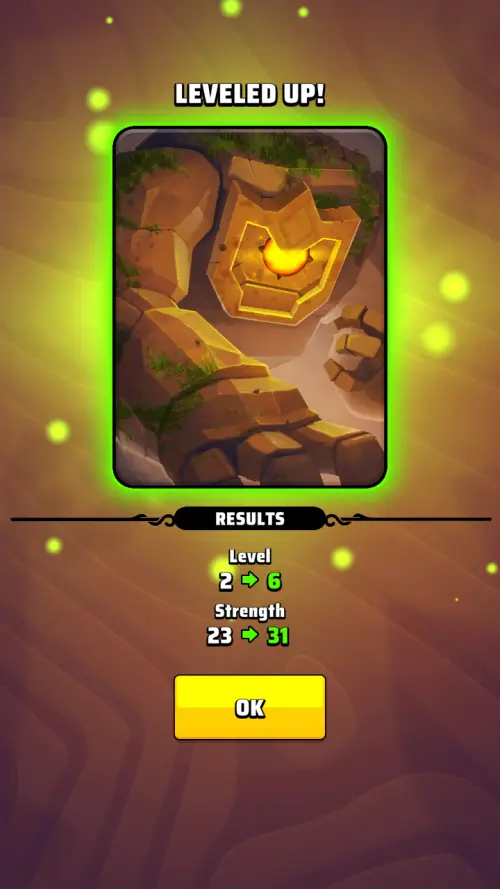
Because of the cost of leveling up cards, you’ll need to both keep rolling for common cards when the opportunity arises and determine which of your cards are worth leveling. As a general guideline, upgrade rarer cards in favor of more common ones. Cards that help others out passively – like Arthur Hightower and his percent-based buff – are also prime targets for leveling up.
Note that levels are capped by evolution levels.
Evolution
Evolution provides a way for you to both promote powerful cards and keep old favorites up to speed. To evolve a card, it must first reach its maximum level. A card’s maximum level can easily be computed as the number of stars it has times 10. Once a card evolves, it becomes level 1 again.
Just like leveling up, evolution requires sacrifices. In this case, you’ll need to give up cards of equivalent rarity:
- 1 –> 2 stars: 1x 1-star cards
- 2 –> 3 stars: 2x 2-star cards
- 3 –> 4 stars: 3x 3-star cards
- 4 –> 5 stars: 4x 4-star cards
- 5 –> 6 stars: 5x 5-star cards
As you can see, this gets expensive very quickly. On the plus side, you can keep rolling for common cards and fatten them up as sacrifices for the few cards you do want to evolve. Or, if you’re lucky enough, you may have some hams lying around that can serve as substitutes for evolution sacrifices.
Because of the amount of effort it takes to evolve cards from 3* onward, carefully consider the value that that card adds to your deck. For example, some utility cards can provide full or great value even at low evolution levels.
Artifacts
Once you clear chapter 2, equipment – called artifacts within Black Deck – will start dropping from campaign battles. By giving your cards better artifacts instead of literally nothing, you’ll be able to squeeze out a bit of extra performance from them. Initially, you’ll be able to equip 7 artifacts, with the last two (ring and banner) becoming available as you evolve a card.
Each piece of gear you give to a unit raises its base strength by a tiny percent (and I’m not exaggerating, we’re talking about 0.x% here) but it does add up. Artifacts also have substats, extra stats tacked on to the miniature strength increase, and each artifact can have up to 3 different substats. In the early game, these substats are very potent as they raise strength by a flat number rather than a percentage. As you keep fighting in the campaign and get artifacts with higher rarity, you’ll start finding artifacts with up to 3 substats.
Artifacts can be upgraded by tapping the upgrade button on the equipment screen. By shelling out some gold, you can raise the level of an artifact to a maximum of +16. Increasing an artifact’s level not only raises its base percent-based strength boost but also improves its substats every four levels. However, upgrading is luck-based. While your gear doesn’t implode on failure, each upgrade attempt does cost a not-insignificant amount of gold.
Each artifact also belongs to a set. By equipping a certain number of artifacts in a set, you’ll trigger a set bonus for that card, giving it even more stats than before. And thankfully, Black Deck does away with fancy set names – these names are indicative of what the bonus is. You can even mix and match artifact pieces to benefit from multiple set bonuses if you’re so inclined.
Or you could just stack sets. And yes, each of them will provide their full bonus.
Ascension and Soulstones
Once you hit rank 8, you’ll gain access to Black Deck’s dungeons.
Dungeons are special levels that feature extra mechanics; the Melee Titan, for example, causes your melee cards to receive double damage. These mechanics present unique challenges that you’ll need to build around to emerge victorious. While difficult, these bosses provide ample rewards in the form of gold, experience potions, artifacts, accessories, and most importantly for this section, Soulstones.
Soulstones can be used to upgrade a card’s evolution stars to give it a substantial boost to its base strength via ascension. Once you have enough Soulstones, go to a card’s info panel and tap ascend to supercharge it.
Two words of warning though: first, a card’s ascension level cannot exceed its evolution level. You can’t purple-coat a star that isn’t there yet. Second, you can never ascend common cards. I’m sorry, Bat.
Skill Levels
Yes, your skills have numbers. But we can make those numbers BIGGER.
By pumping up a card’s skills, you’ll get a lot more mileage out of them – not only do the numbers go up, but in some cases, you’ll also gain side upgrades such as improved duration. The catch here is that you will need either duplicates of a card or use tomes to raise skill levels.
Once again, refer to my comment about “common cards being more useful via abilities”. Poison Rats with level 5 poison attack are nothing to laugh at.
The Town Hall and PVP
The Town Hall is a great way to boost your deck’s overall power if you’re running a faction-based deck.
Every battle in the arena awards you tokens. These tokens can be invested in a faction-wide passive boost to strength. Simple? Yes. Useful? Oh yes.
For those not too fond of PVP, don’t worry – arena battles are against an AI using that player’s defense deck. Of course, this means that you’ll need to make a good defense deck of your own!
Apart from tokens, PVP also gives out rewards via daily milestones and league rankings, but more on that later.
Minting NFTs
Really? Yes really.
If you really want to give a card extra power, you can mint it as an NFT with all the bells and whistles that adds – such as being able to sell it to other players. You’ll also need to link a crypto wallet to your Black Deck account to do so.
Look, I’m all for definitive upgrades in games especially when it comes to paying real cash, but I can’t recommend doing this. It’s a miniature upgrade in strength and a 5% crit rate boost that you can get via artifact sets. There’s plenty of fun to be had in Black Deck without delving into NFTs, and if you really want to support the game, why not just get the ad removal pack?
Getting Free Stuff
Now that you know where to spend your resources, let’s talk about where to get more of them – especially free stuff. Everyone loves free stuff, right? This section will expound on where to get free (or mostly free) resources; it won’t go into detail about things that are evident such as gold and cards from campaigns or Soulstones from dungeons.
Quick Tips
- You get prizes for fighting up to 30 PVP matches per day, whether you win or lose. The higher your PVP rank, the better the milestone rewards are.
- Do Treasure Tower daily as there’s an 18-hour waiting period for another attempt. Enter the tower via the Dungeon menu.
- Staying logged on counts as progress for the activity bar to a maximum of 3 hours. You get free hero rolls and resources from this.
- Visit your codex to claim gem rewards from new cards as well as milestone rewards for reaching certain thresholds.
- You can get free common rolls via ads. You can also view ads to roll again for stage clear loot – great when you’re low on stamina.
- The shop offers a free blue roll on a 1-week cooldown and a free common roll on a 1-day cooldown.
- Daily login rewards are unlocked as you rank up. These give out rare cards on occasion, so try not to miss them.
- You can complete challenges, missions, and quests for bonus resources. All of them give out nice stuff, so strive to complete them all. Completing all monthly quests grants you one premium summon.
- Puzzles are unlocked by completing a certain number of stages. These will test your arithmetic skills but will reward you with rare and valuable resources.
- Black Deck regularly holds events. Tap the events icon on the lower right corner of the main menu to see event mechanics, rankings, and claim rewards.
- Check to see what the market has every hour. It’s not free, but will sometimes allow you to get the resource you need for gold.
- The gem mine very slowly gives gems. Unless you’re actively buying gems, it’s not worth investing in it.
PVP
If the medals for your town hall aren’t enough of an incentive for you to participate in PVP, you’re missing out on quite a bit. It’s not just medals that people go for in PVP – it’s also experience potions, gold, and chests that are up for grabs.
These rewards are tied into PVP’s milestone system. The more fights you do per day (yes, win or lose), the more progress you make in your milestones. Once you’ve fought enough times per day – that’s at 6, 10, 20, and 30 fights – you get a reward. Just tap the fight button and close your eyes.
On top of this, the amount of resources your milestones pay out is dependent on your current PVP league. Each PVP fight will either increase or decrease your PVP rank, as indicated by the +/- sign by the trophy. Raise your rank high enough and you’ll get into the bigger and better leagues.
Watch out though – since leagues reset, you may be matched against enemies with combat power leagues ahead of your own. If you’re looking to raise your rank quickly, or if you’re hopelessly outmatched, you can refresh your PVP opponents for free every 15 minutes or by paying 5 gems.
Treasure Tower
While Treasure Tower technically isn’t free as you have to fight to earn stuff, it’s a great source of materials. This dungeon unlocks once you hit roughly rank 10 (if my memory serves).
Treasure Tower battles are a marathon – you start at the lowest floor you’ve cleared and keep fighting (without breaks or refreshes so your strength and dead cards persist) until you lose. Uniquely, Treasure Tower battles also offer buffs in the form of monoliths, gold piles, or caged cards that join your deck if you free them. Leveraging these mechanics while keeping a tight lid on your greed for more gold is key to progressing further in the tower.
The higher you climb, the better the stuff you’ll find – not only can you get artifacts from various sets, but also chests and even rare card fragments. But take note – there’s a waiting period of around 18 hours before you can attempt to climb the tower again.
Activity Reward
Just playing the game gives you free resources, but you’ll need to claim these at the activity rewards menu.
Stay logged in for 3 hours daily to get gold, free rolls, some stamina, and a pittance of gems. And no, you don’t even have to be playing. You can just leave the app on.
Card Collection
The more unique cards you amass, the more rewards you can claim.
New cards give you a few gems that you can nab by tapping on their portrait. It’s not much, but it does add up. More importantly, each unique card you get contributes to your codex progress, which you can access at the upper-right of the main menu.
Upon reaching certain card collection thresholds, you can get a prize from the collection meter similar to PVP’s milestone bar. Most importantly, this gives a purple summon token for 15 unique cards collected, which will hopefully get you a card that you can build around.
Ad Bonuses
The game is very determined to make you watch ads. It’s annoying, but the flip side of this is that there’s quite a bit of “free” stuff you can get by watching ads – namely common rolls and stage rewards.
The summoner’s gate accepts time as currency. By watching an ad, you can skip the need to pay with either common tokens or gems. And yes, ad rolls count toward pity.
Stage rewards can also be ad-doubled. Watching an ad at the end of the battle rolls another item from the level’s loot table, meaning free drops. This also has the plus side of not costing stamina, so if you’re running low you may want to opt for ad rewards instead of rerunning levels.
Shop Offers
You can get free rolls from the shop. These are on a timed cooldown, so nab them as soon as you can.
The cooldowns are 1 week for an elite summon token (blue) which will net you at least a rare card, and 1 day for a common roll.
Logins, Missions, Challenges, and Quests
Par for the course are logins, missions, challenges, and quests.
Login rewards are unlocked after leveling your rank up a bit. These give out resources every day. More importantly, daily login rewards also give rare and epic cards after a month of logging in!
Missions, challenges, and quests are almost the same in that they both reward you for doing things, except:
- Missions are meant to guide you through game progression and give out rich one-time rewards. These must be completed in order.
- Challenges are more difficult tasks that give out modest rewards. Do them if you can.
- Quests are divided into dailies, weeklies, and monthlies, and consist of easy tasks that you’re likely to do in the course of normal gameplay.
Aim to accomplish them all; challenges will give you the kickstart to take off in the early game while quests will help you with your resource upkeep. Of note is the reward for completing all monthly quests: one premium unit token!
Puzzles
Remember all those mobile ads where they ran guys through mathematical fields to increase their numbers? Yeah, Black Deck has those too.
You can play puzzles via the campaign menu if you have enough puzzle pieces. These pieces can be acquired from clearing campaign stages. The more stars you get when you clear a stage, the more puzzle pieces you get – up to 3 per level. Do note that you only get puzzle pieces for clearing new stages or earning new stars; you can’t go back to stage 1-1 and grind them out!
Events
Almost every game has events and participating in them is a great way to get free stuff.
To view what events are currently running, what you need to do for each of them, and to claim your prizes, tap the event button on the main menu on the lower right corner of the screen.
The Market
I’ll admit – the market isn’t free. But it’s sometimes cheap, which is almost as good as free. And hey, if you get a resource by paying for it in coins instead of time and stamina, I’d count that as a win!
The market sells a random assortment of hours every hour, which can include artifacts, roll tokens, and even cards. Be sure to check the market whenever it refreshes – you might just find the very thing you need up for sale!
The Gem Mine
The Gem Mine is this big, wealthy-looking building to the left side of your town. Yes, it produces free gems. No, it is a laughable amount. I did say free stuff, not “good” free stuff.
Some quick mental math shows that the gem mine will pay for its first upgrade in around 100 days. It can be viable if you’re in it for the really long haul. At least it gives you enough gems for a refresh every day.
The Battlefield Awaits!
The road to glory is long and arduous, but now you’re armed with the technical know-how to not only get a good beginning but also ensure consistency and create a long-term plan for developing your deck and cards.
That concludes our guide to Black Deck, and I hope I was able to answer “what am I supposed to be doing” if you’re a new player and help you get some tips and tricks to use in your journey to the top. If you have any suggestions on how to improve this guide or would like to share some of your own advice, make yourself heard in the comments below!

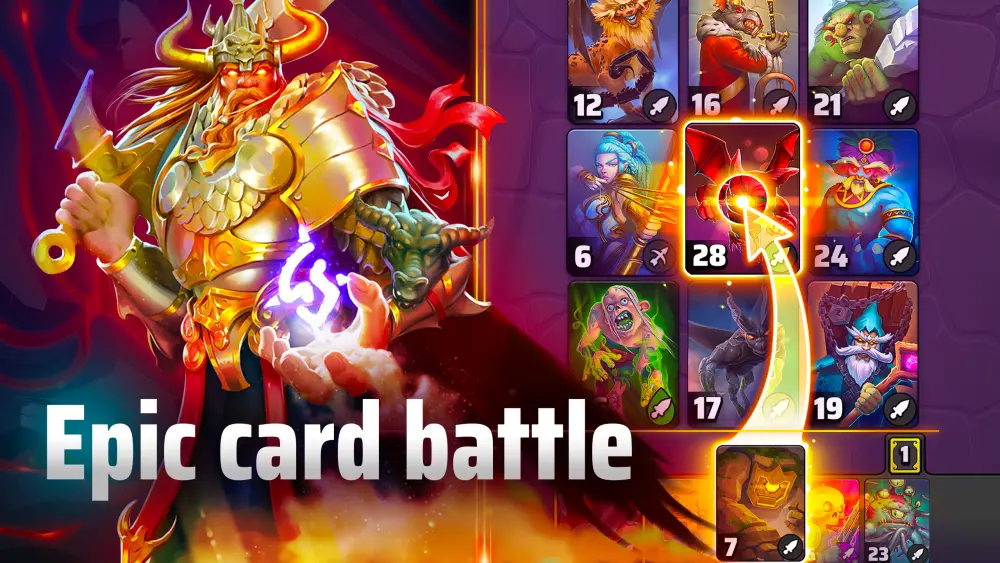
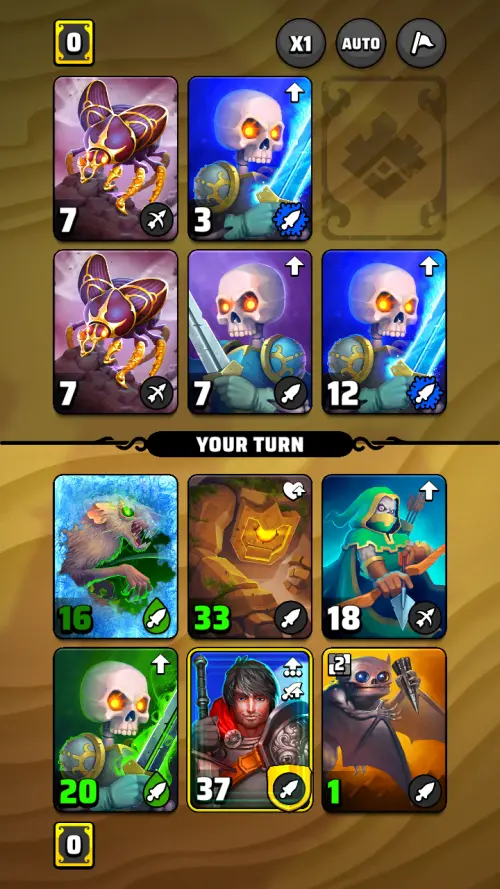
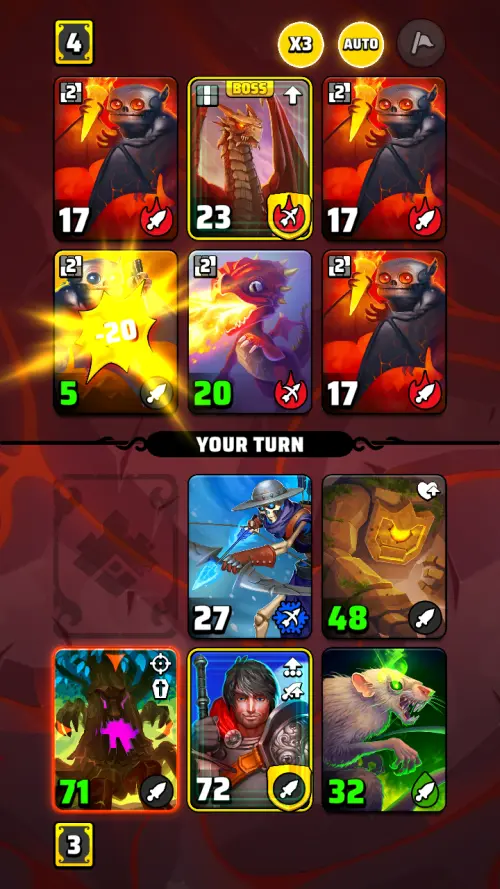
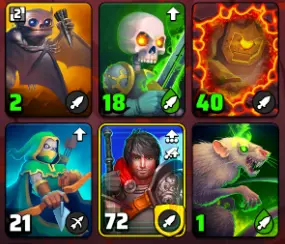
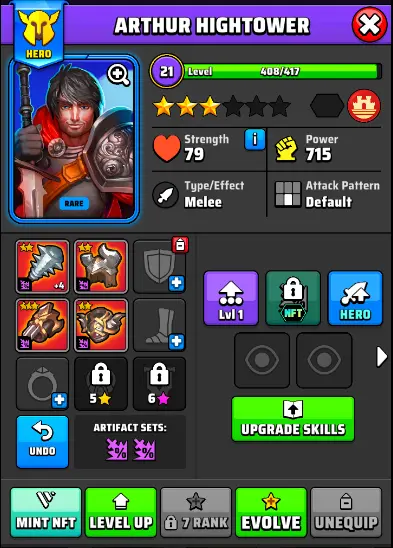
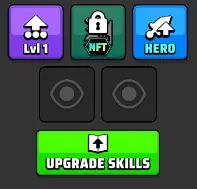
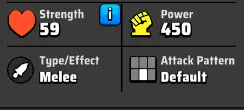
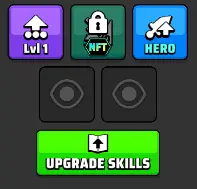
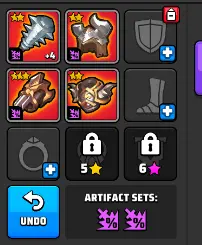
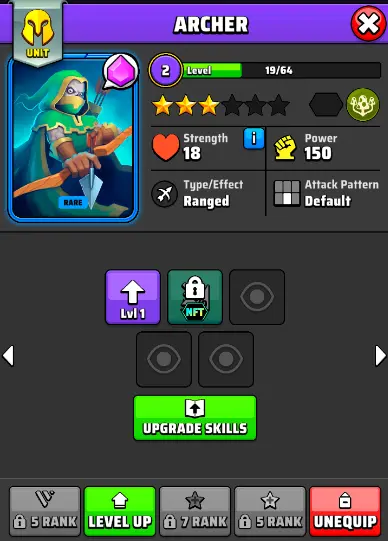
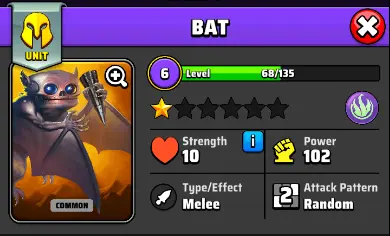
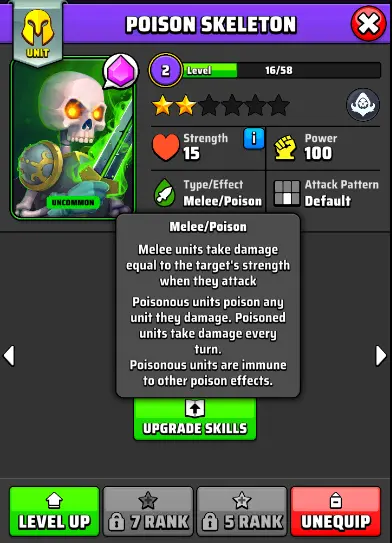
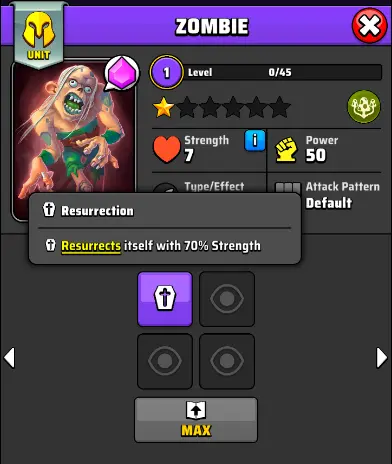
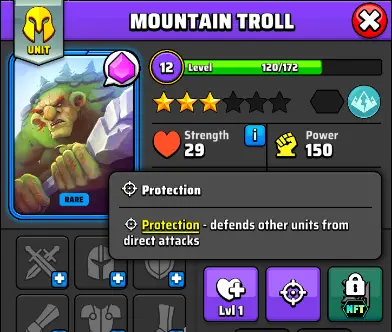
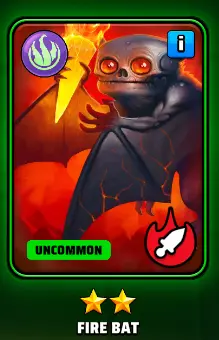
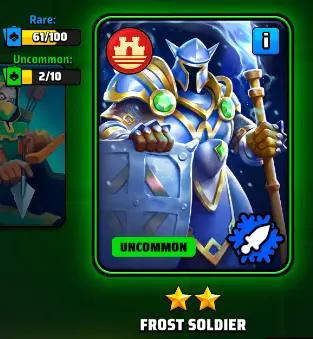
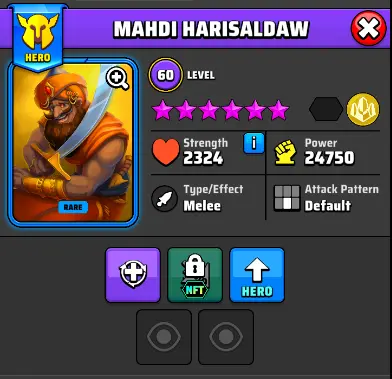
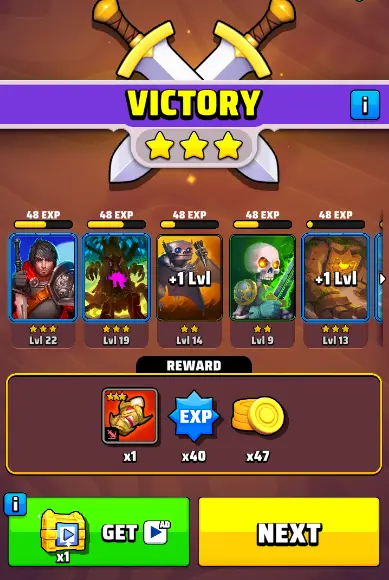
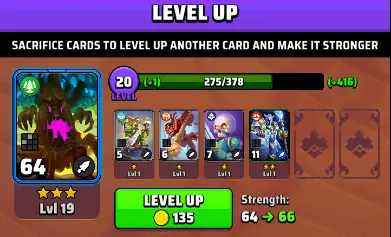
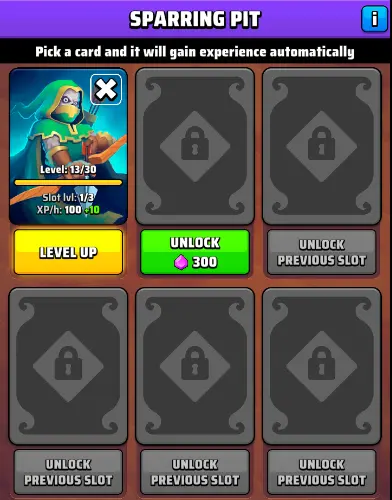
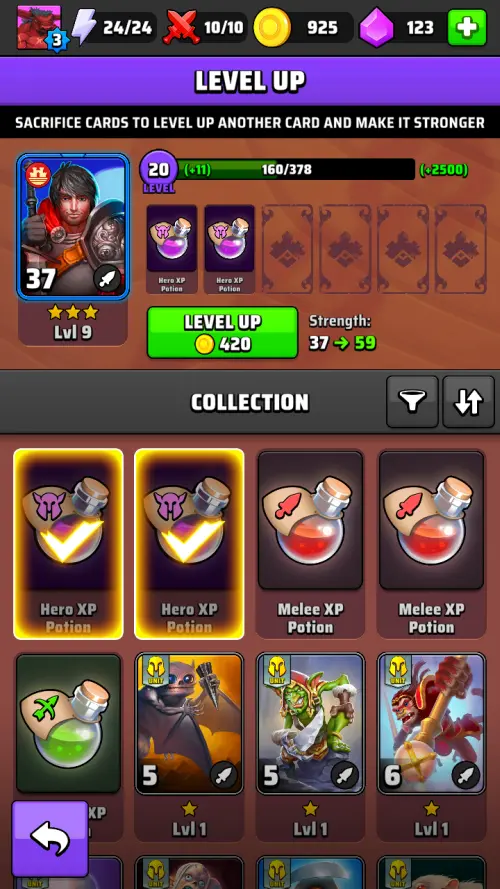
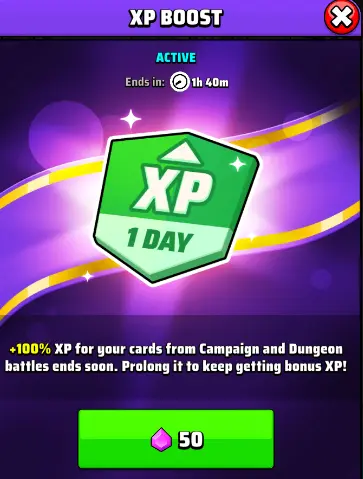
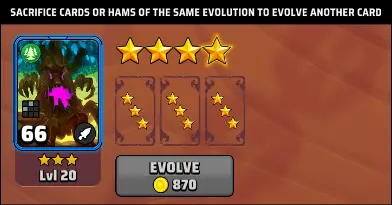
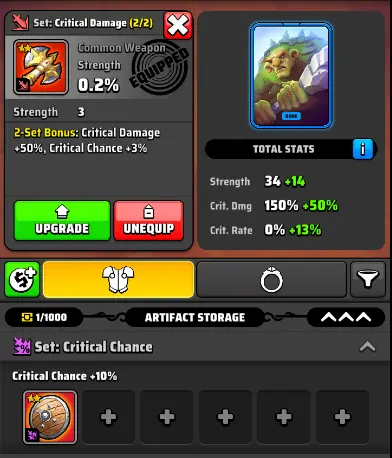
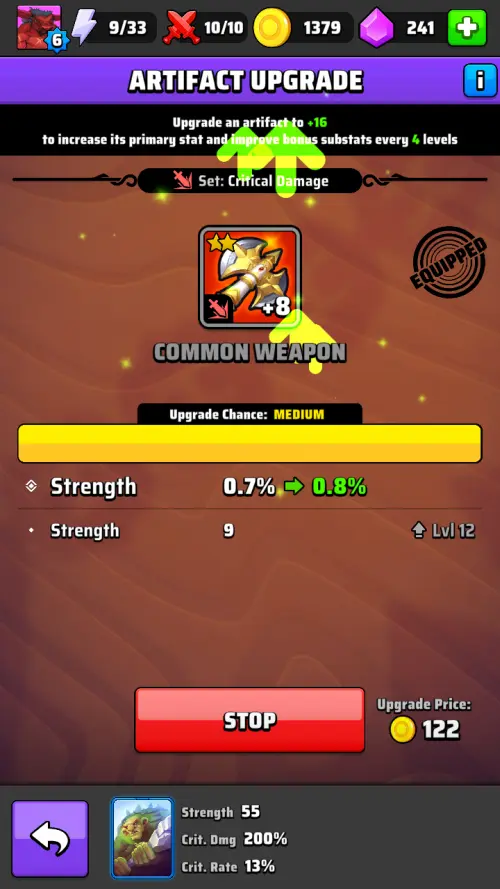
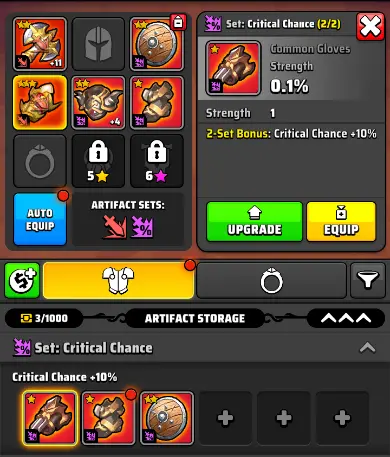

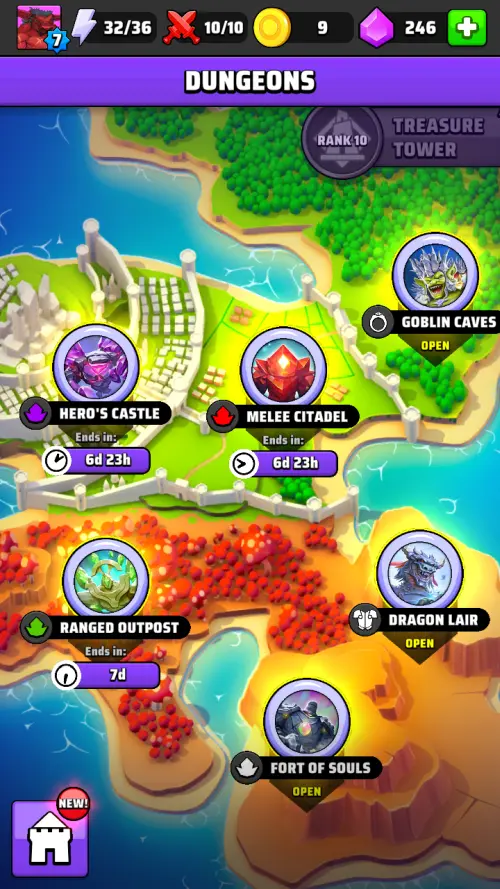
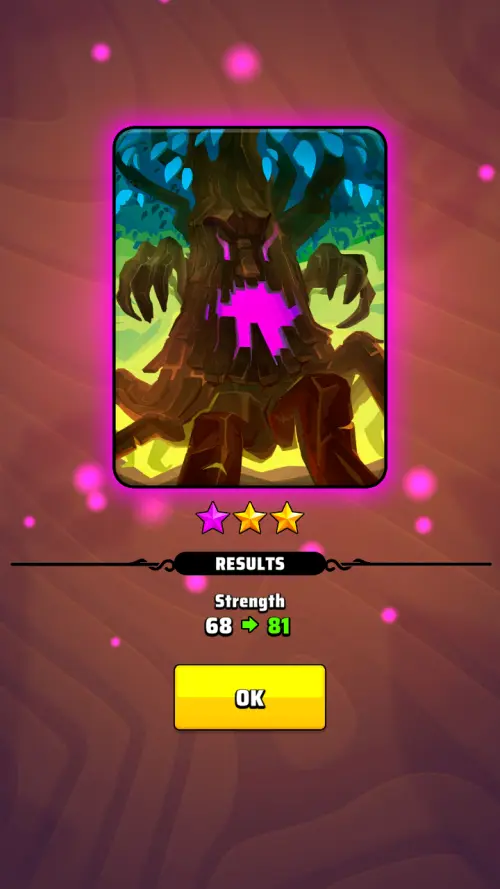
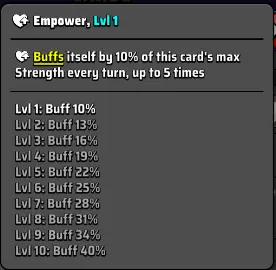
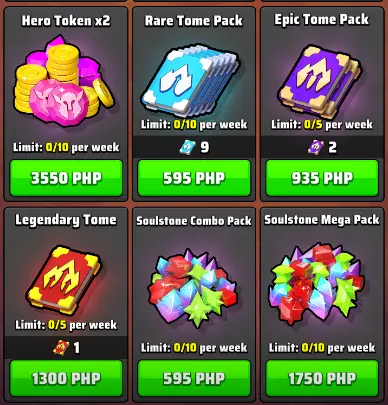
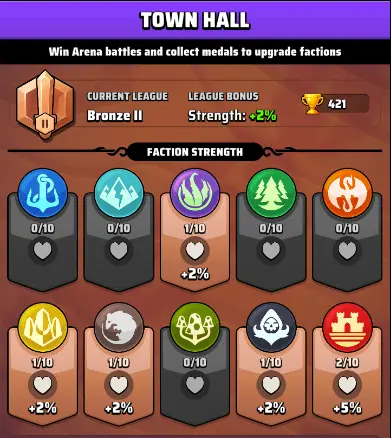
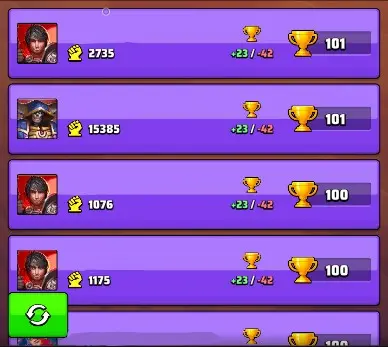
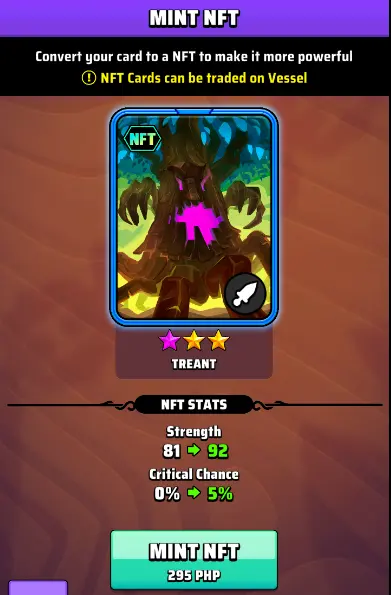

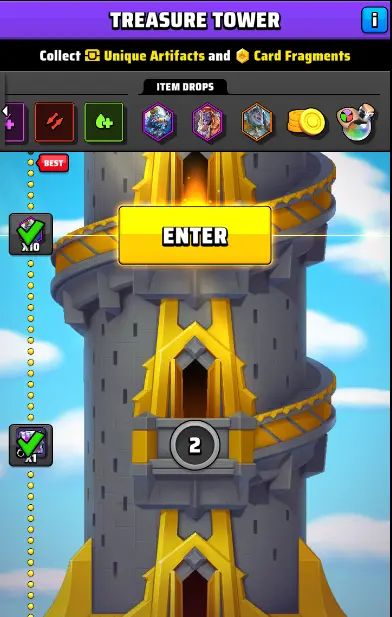
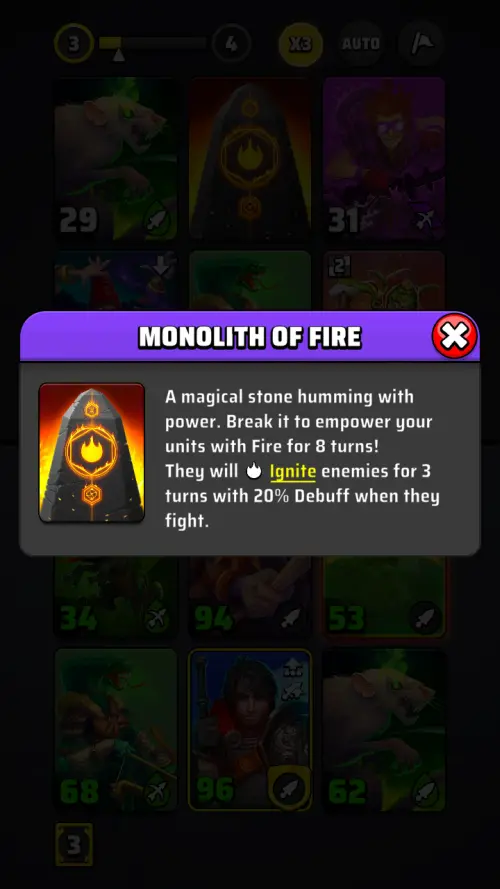
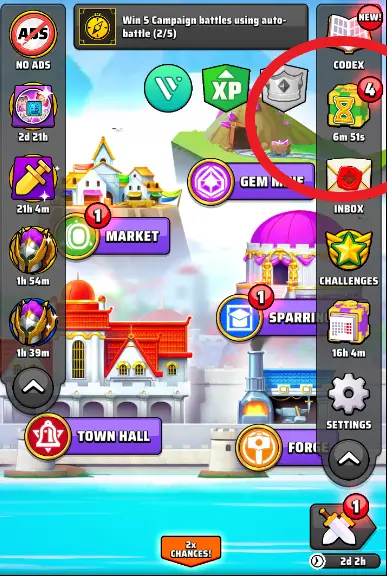
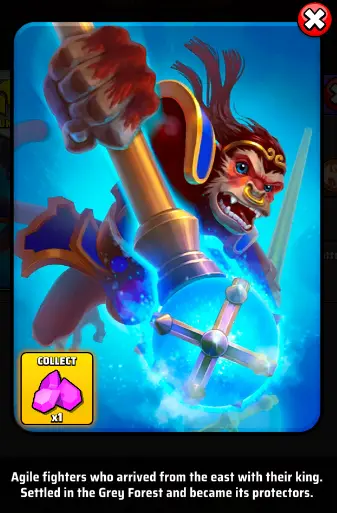

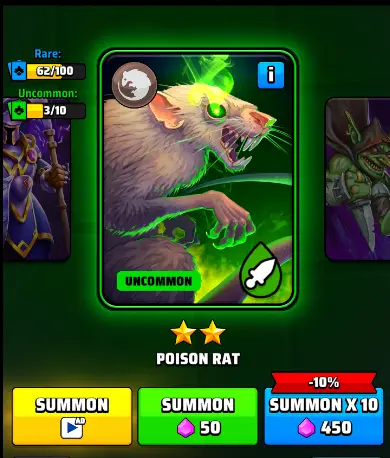
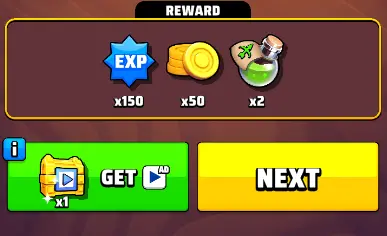
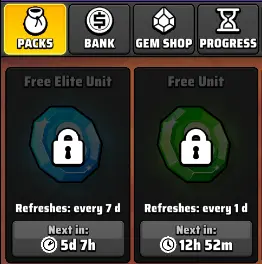
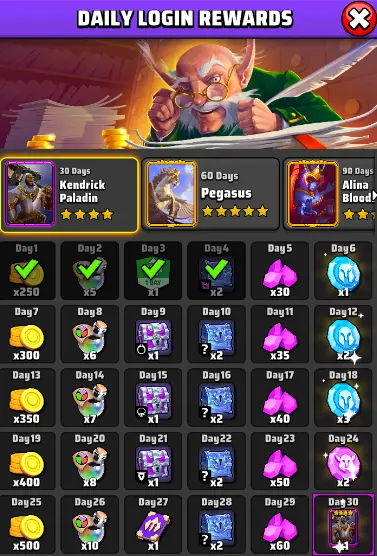
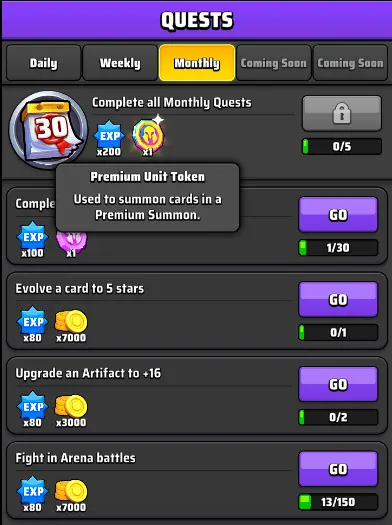
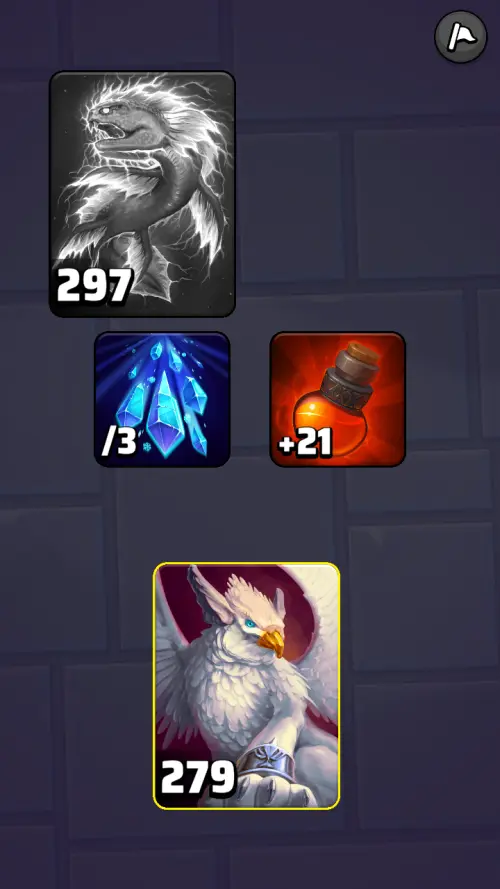
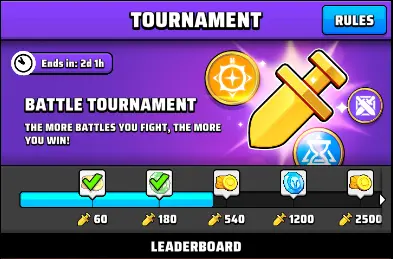
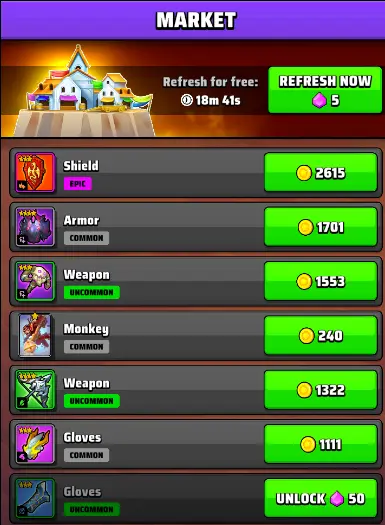
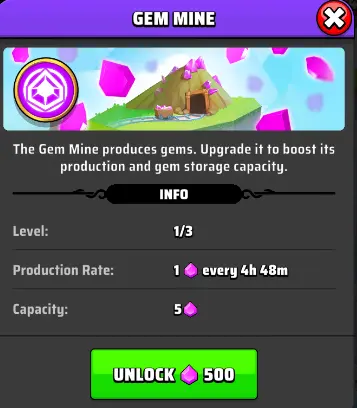
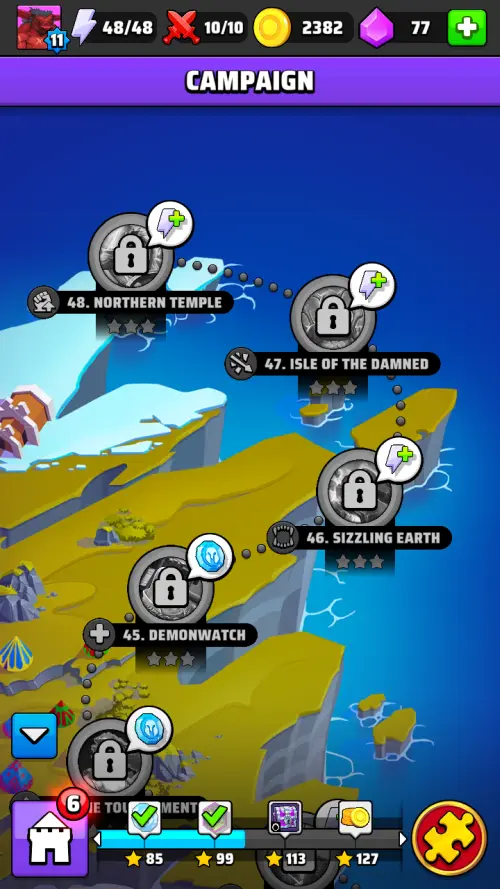
matt
Wednesday 3rd of July 2024
how do you use food (the hams) to level up? thanks
Jay
Friday 8th of December 2023
Gear also has affinities for faction and card type eg. swamp and ranged. Is there a specific way to get these to align with the cards you want to use them in or is that down to hours of searching? If I've missed this info somewhere or anyone knows more, any info would be appreciated 🙏
Gravitier
Monday 2nd of October 2023
I would like to know what to do with the fragments that i earn in puzzles or at the tower. It tells me to use at the forge, but i don't see how. Does anybody know?
Jason
Wednesday 4th of October 2023
@Gravitier, go to summon, bottom middle, and then in the top right you can select fragment, from there you can see how many you have collected and how many more you need before you can summon.
Ali K
Tuesday 11th of July 2023
What can we do with extra artifacts we don’t need? Can we sell them after we have them?
Rik Heeren
Tuesday 11th of July 2023
Hoe do you delete you current account or can you start over with nothing again? Please let me know.